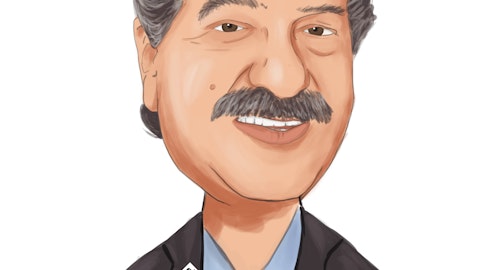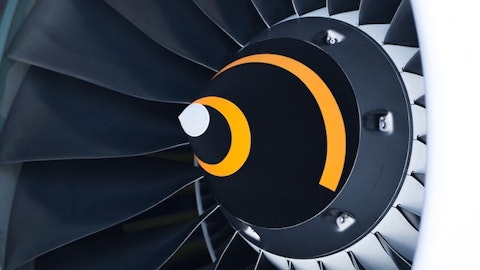Barnes Group Inc. (NYSE:B) Q3 2023 Earnings Call Transcript October 27, 2023
Barnes Group Inc. misses on earnings expectations. Reported EPS is $-0.42559 EPS, expectations were $0.51.
Operator: Hello. And welcome to the Barnes Third Quarter 2023 Earnings Conference Call and Webcast. All lines have been placed on mute to prevent any background noise. After the speakers’ remarks, there will be a question-and-answer session. I will now turn the conference over to Bill Pitts, Vice President of Investor Relations. Please go ahead.
Bill Pitts: Thank you, Joel. Good morning. And thank you for joining us for our third quarter 2023 earnings call. With me are Barnes’ President and Chief Executive Officer, Thomas Hook; and Senior Vice President, Finance and Chief Financial Officer, Julie Streich. If you have not received a copy of our earnings press release, you can find it on the Investor Relations section of our corporate website at onebarnes.com, that’s O-N-E-B-A-R-N-E-S.com. During our call, we will be referring to the earnings release supplement slides, which are also posted on our website. Our discussion today includes certain non-GAAP financial measures, which provide additional information we believe is helpful to investors. These measures have been reconciled to the related GAAP measures in accordance with SEC regulations.
You will find a reconciliation table on our website as part of our press release and in the Form 8-K submitted to the Securities and Exchange Commission. Be advised that certain statements we make on today’s call both during opening — the opening remarks and during the question-and-answer session maybe forward-looking statements as defined in the Private Securities Litigation Reform Act of 1995. These forward-looking statements are subject to risks and uncertainties that may cause actual results to differ materially from those projected. Please consider the risks and uncertainties that are mentioned in today’s call and are described in our periodic filings with the SEC. These filings are available through the Investor Relations section of our corporate website at onebarnes.com.
Let me now turn the call over to Tom for his opening remarks. Then Julie will provide a review of our financial performance and details of our updated 2023 outlook. After that, we will open up the call for questions. Tom?
Thomas Hook: Thank you, Bill, and good morning, everyone. It was a particularly intensive third quarter in which we made significant progress towards several strategic objectives. We have aggressively moved Barnes to a more balanced value driven business through execution of our strategic priorities to drive core business execution, scale Aerospace and optimize Industrial. While we are pleased with progress in several areas, our success to-date is unfortunately been asymmetric. Across the organization, overhead remained stubbornly high and while it is being methodically addressed, it is been a slower than desired pace. Aerospace has demonstrated it’s on the right path convincingly. While performance is generally strong, it is not perfect given two struggling Aerospace manufacturing facilities.
Industrial has proven to be much more challenging than originally anticipated. Structural changes needed to Integrate, Consolidate and Rationalize that portion of our portfolio are well underway, including additional initiatives commenced in the third quarter. There remains considerable work to complete, leveraging the foundational elements, we have painstakingly put in place. However, progress will not be linear. Our strategy to enhance and grow our Aerospace business took a major LEAP forward. During the quarter, we successfully recapitalized the company’s debt and completed our acquisition of MB Aerospace earlier than expected. We welcome the MB Aerospace team to Barnes and celebrate the largest acquisition in the company’s history. This is a major step to establishing a more balanced portfolio overall for Barnes.
We are off to a fast and effective start integrating MB Aerospace and have established traction to deliver the synergies we referenced when we announced the acquisition. The emphasis on driving integration and synergies from day one is a significant shift from our previous acquisition practices. The benefits are already apparent and how the teams are engaging and the pace of integration is progressing on all fronts. This approach will set the standard for future deals to ensure success. With respect to Aerospace performance, last quarter we identified two facilities operating inefficiently and weighing on our results. One of facilities, an OEM location is starting to turn the corner as we head into the fourth quarter. The other, an aftermarket facility continues to face challenges.
The ultimate fix for this facility requires a ramp in commercial activities to build a robust pipeline that generates additional bookings. Continued corrective actions and investments are being implemented to bring these facilities to higher levels of performance as we move into next year. Previously announced transformation products touching Aerospace are making steady progress to increase capacity and capabilities. These investments secure our ability to grow across our Aerospace and markets with all customers. Our fourth quarter forecast looks solid and we believe that we are well-positioned heading into 2024. In addition, we recently announced two extended long-term agreements with Safran. The first agreement is for the repair and overhaul of components for the LEAP and CFM engine programs, reflecting Barnes’ Aerospace expertise in machining and assembly of complex engine components.
In the second agreement, we extended a CFM56 Component Repair Agreement, which will secure this mutually beneficial program over the long-term. Combined, we expect these to represent over $65 million in future revenues. To close my remarks on Aerospace, one of the more promising developments with our now larger business is new commercial opportunities. Customers recognize our expanded capabilities and have already engaged with our combined commercial and engineering teams to identify work packages we have not participated in previously. We look forward to sharing more details on these new opportunities with you at the appropriate time. At Industrial, our core business execution is unacceptable, which is driving a very strong mandate for continued change.
This includes cost rationalization efforts within Motion Control Solutions and restructuring within Molding Solutions. My direct involvement in Industrial operations leadership, which began in May, is providing first-hand appreciation of the need for ongoing strategic, operational and leadership changes. These changes are actively being made to streamline excessive overhead, strengthen commercial go-to-market strategies and improve manufacturing and capacity and capability. Our Integrate, Consolidate, Rationalize products are generally delivering expected results. However, we are seeing leakage of these benefits due to ongoing pressures of the weak China markets and continued inflation in labor and materials. We have made progress on our manufacturing facility optimization products with the closure of manufacturing plants in Molding Solutions and Motion Control Solutions.
This includes the closure of our associated spring plant in Bristol, Connecticut. Additionally, some smaller underperforming technology and service centers in our Automation business have also been shut down. At Molding Solutions, we implemented a restructuring project with objectives to integrate the business comprehensively and streamline the organization. These changes included, integrating our commercial capabilities to more aggressively sell our systems and services globally, optimizing the effectiveness and efficiency of our global manufacturing footprint, accelerating our technical leadership in bringing new products and services to market, and streamlining back office business processes and analysis. During the quarter, we took an additional restructuring charge to accomplish the above.
These changes include also coincide with several leadership changes. We reduced the size of the leadership team at Molding Solutions and implemented additional overhead reductions across the business, significantly reducing complexity and expense. I am also pleased to share that earlier this week, we appointed a new President of Molding Solution, Marcello Vendemiati, who has led the transformation of our Automation business over the past two years, will move into Molding Solutions President role full-time effective November 1st. This move created an opportunity for an additional internal promotion. Emanuele Orlando, who is instrumental in reinvigorating the growth of our multi-cavity business, will now transition to lead the Automation business.
Our Motion Control Solutions business, which manufactures auto component parts is feeling the effects of the ongoing United Auto Workers strike. While the third quarter impacts were isolated, we expect shipment delays and lagging orders in the fourth quarter. Our preliminary estimate is $6 million plus in revenue impact and a $1.5 million plus profit impact in the fourth quarter. However, the unpredictability of the strike may also require additional layoffs or furloughs to mitigate additional impacts. If the duration of the work stoppage continues, there is a risk of broader contagion to our nitrogen gas products and automotive hot runner product lines. At Automation, we continue to anticipate full year growth despite a large distribution partner significantly lowering volume in 2023.
The year-over-year growth offsetting this major headwind speaks to the effectiveness of our refreshed commercial strategies. We are also working closely with our distribution partner to course correct demand trends. The distributor is projecting a 2024 recovery in core product lines and is also adding our vacuum product line to their sales channel. Overall, however, as we look to the fourth quarter, our industrial outlook has eroded on industry dynamics, softening demand and inflationary pressure. In closing, we are aggressively moving Barnes to a more balanced value-driven business through execution of our strategic priorities to drive core business execution, scale Aerospace and optimize Industrial. Significant progress has been made in strategically adding to our Aerospace business with the addition of MB Aerospace in the quarter.

Progress towards previously announced restructuring actions continues as planned across all businesses. And in Industrial, major structural changes are being implemented to reduce costs and enhance our commercial capabilities. While Industrial progress is not moving at the desired pace yet, specific targeted actions are underway and our commitment to achieving the Industrial turnaround remains very strong. Let me now pass the call over to Julie for a discussion of our third quarter performance, as well as some end-market color.
Julie Streich: Good morning, everyone, and thank you, Tom. Let me begin with highlights of our third quarter results on slide four of our supplement. Third quarter sales were $361 million, up 15% from the prior year period, with organic sales increasing 4%, acquisition revenues contributing 8% and foreign exchange adding 3%. Adjusted operating income was $39 million this year, which is the same as a year ago and adjusted operating margin of 10.8% was down 160 basis points. Net loss was $21.7 million or negative $0.43 per diluted share, compared to net income of $17 million or $0.33 per share, a year ago. On an adjusted basis, net income per share of $0.19 was down from $0.49 a year ago. Adjusted net income per share in the third quarter of 2023 excludes $0.19 of restructuring and transformation-related charges, $0.31 of acquisition-related charges and $0.12 of MB Aerospace acquisition short-term purchase accounting adjustments.
Third quarter interest expense was $22.8 million versus $3.4 million a year ago. The key driver of the increase was the MB Aerospace acquisition. At the time of closing, we recapitalized Barnes with a fresh $1 billion revolver and a new $650 million Term Loan B. I will discuss our new debt structure and leverage momentarily, but to — suffice it to say that a higher average debt balance and a higher average interest rate in the quarter contributed to the increase in interest expense. In addition, one-time bridge financing fees of $9.5 million were incurred in anticipation of the acquisition, which are included in interest expense and excluded from our adjusted earnings as acquisition-related charges. Other income was $900,000 versus other expense of $2.4 million a year ago, primarily driven by non-operating pension income.
The effective tax rate in the third quarter of 2023 was negative 82%, compared to 30% in the year-ago period and approximately 65% for the full year 2022. The unusual tax rate in the third quarter this year is driven by effects from the non-deductibility of a portion of our interest expense, transaction costs associated with the MB Aerospace acquisition that are capitalized for tax and a change in the geographic mix of forecasted earnings. The unusually high 2022 tax rate is primarily due to a goodwill impairment charge, which is not tax deductible and limitations on executive compensation deductions. Now I will turn to our segment performance beginning with Aerospace. At Aerospace, sales were $156 million, up 41% from a year ago. On an organic basis, sales increased 17% in the quarter, while the MB Aerospace acquisition increased sales by 24%.
OEM organic sales increased 24% and aftermarket organic sales increased 7%. Operating profit was $3.6 million versus $21.2 million a year ago. Excluding restructuring and transformation-related charges of $3.9 million, acquisition transaction costs of $7.8 million and short-term purchase accounting adjustments of $8 million, adjusted operating profit of $23.4 million was up 12% from a year ago. Adjusted operating margin was 15%, a decrease of 380 basis points from prior year. Adjusted operating profit benefited from the contribution of higher organic sales volumes, inclusive of pricing and the contribution of MB Aerospace sales, partially offset by productivity. Keep in mind that operating margins will be impacted by both short-term purchase accounting adjustments and long-term intangible amortization from the MB Aerospace acquisition.
While the short-term purchase accounting impacts are excluded in adjusted results, the long-term intangible amortization is not. This will have a meaningful impact on reported margins. Legacy OEM orders were up 29% in the quarter and book to bill was 0.6 times. With the combined Barnes and MB Aerospace business, our OEM backlog now stands at $1.25 billion and we expect to convert approximately half of this backlog to revenue over the next 12 months. Our 2023 organic sales growth outlook is up high-teens for OEM, high-teens for MRO, and low double digits for spare parts. Collectively, Aerospace full year organic sales growth is expected to be in the high-teens, which is consistent with our July outlook. Our forecast for Aerospace adjusted operating margin is approximately 15.5%, driven in part by long-term intangible amortization, OEM aftermarket mix of the combined entity and the ongoing recovery process in two of our facilities.
At Industrial, third quarter sales were $205 million, up slightly from the prior year period. Organic sales decreased approximately 3%, while favorable foreign exchange was a positive 4%. Industrial’s operating profit was $6.4 million versus $8.8 million a year ago. Excluding restructuring and transformation-related charges of $9.3 million, adjusted operating profit of $15.6 million was down 14% and adjusted operating margin of 7.6% was down 130 basis points. Adjusted operating profit was impacted by lower organic sales volumes, unfavorable mix and lower productivity, partially offset by positive pricing. With respect to orders and sales for the quarter across Industrial, Molding Solutions organic orders decreased 7%, while organic sales decreased 2%.
Trends that have been in place for several quarters persist. Our multi-cavity mold systems delivered organic, excuse me, delivered orders and sales growth primarily driven by packaging and personal care. These were offset by weakness in our hot runner product line serving automotive end-markets. For 2023, we now expect Molding Solutions organic sales to be approximately flat. At Motion Control Solutions, organic orders and sales both decreased by 5% in the quarter, as has been the trend we saw good orders and sales driven by transportation-related end-markets in our Legacy Engineered Components business. However, as Tom mentioned, we expect that to turn negative in the fourth quarter with the ongoing UAW work stoppage. Sheet metal forming end-markets remain stubbornly soft, especially in China.
We now forecast flat organic sales growth for MCS in 2023. At Automation, organic orders were down 18%, while organic sales were approximately flat. We expect mid-single-digit organic sales growth for Automation in 2023, a bit lower than our prior view. For the Industrial segment, we anticipate flat organic sales growth for 2023 with adjusted operating margin of approximately 8.5%. Before moving on to cash, I’d like to take a moment to walk our adjusted EPS from the third quarter of last year to the third quarter — to the current year quarter on slide six of our supplement. As mentioned, there are a lot of moving pieces in the quarter and I want to isolate performance drivers of adjusted EPS. In looking at the graph, it becomes clear that MB interest and tax impacts are what drove the majority of the year-over-year decline in adjusted EPS.
With respect to cash performance, cash provided by operating activities was $71 million year-to-date versus $43 million in the prior year period. The primary drivers continue to be from lower paid incentive compensation in 2023 relative to 2022 and a lower investment in working capital compared to the prior year. Free cash flow was $34 million versus $22 million last year and capital expenditures were $37 million, up approximately $16 million from prior year. As I mentioned earlier, with the MB Aerospace acquisition, we have recapitalized the company to provide the financing needs to close the deal and to ensure sufficient capital for our ongoing needs. The new capital structure consists of a $1 billion revolving credit facility with a five-year term and a $650 million Term Loan B with a seven-year term.
Each facility uses SOFR as the base, with the revolver having an interest spread ranging from 1.375% to 2.5% based on leverage and the term loan, having a fixed 3% spread. At quarter end, approximately $660 million of the revolver was drawn. Within that, approximately $320 million of the revolver debt is EURIBOR-based and comes with an approximate 160 basis point lower average rate. All-in, our new financing structure has an average interest rate of around 7.7% before swaps. In order to reduce exposure to rising interest rates, we have hedged approximately $865 million of debt, creating a debt profile that is approximately 65% fixed and 35% variable. With the interest swaps in place, the average interest rate on our debt all-in is approximately 6.8%.
With our balance sheet, the net debt-to-EBITDA ratio as defined by our new credit agreement was 3.8 times at quarter end. We now anticipate being around the same level at year-end and approximately 3 times at the end of 2024. Turning to slide seven of our supplement, we will move to our updated 2023 outlook. We now expect organic sales to be up 5% to 6% for the year with adjusted operating margin of between 11% and 12%. We forecasted adjusted EPS in the range of $1.57 to $1.67 down from 2022’s adjusted earnings of $1.98 per share. 2023 adjusted earnings per share are anticipated to exclude $0.70 related to restructuring and transformation-related activities, $0.36 related to acquisition transaction costs and $0.34 of short-term purchase accounting adjustments.
With the changes in interest and tax rates, the latter largely driven by interest expense disallowance, we now forecast the impact of the MB Aerospace transaction to be approximately 40% dilute — $0.40 dilutive in 2023 and remain dilutive in 2024. A few other outlook items. Interest expense is anticipated to be approximately $50 million, excluding the $9.5 million of bridge loan fees; other income to be approximately $3 million, excluding $1.1 million of pension income attributable to restructuring activities; we anticipate a full year adjusted effective tax rate of between 31% and 32%; CapEx of approximately $50 million; average diluted shares of approximately $51 million; and free cash flow of approximately $70 million. In closing, we executed several major transformational actions during the quarter to better position Barnes for long-term value generation.
As Tom mentioned, our announced restructuring efforts remain on track and we continue to see green shoots from our commercial efforts. Delivering improved industrial performance remains the most significant operational challenge we face. Given our core business execution focus, we will turn the corner and deliver results reflecting the underlying potential of the business. Operator, we will now open the call for questions.
See also 30 Best Places to Visit in Mexico that are Beautiful and Safe and Movie Studio and News Media Stocks List.
Q&A Session
Follow Barnes Group Inc (NYSE:B)
Follow Barnes Group Inc (NYSE:B)
Operator: Thank you. [Operator Instructions] One moment for your first question. Your first question comes from the line of Pete Osterland of Truist. Your line is open.
Pete Osterland: Hey. Good morning, Tom and Julie. Thanks for taking our questions.
Thomas Hook: Welcome, Pete.
Pete Osterland: The first — I appreciate the chart on the year-over-year EPS walk. So along similar lines for Aero margins, when we look at the year-over-year decline in the quarter there, how much of that was from the impact of the acquisition and how much is organically related to productivity or mix or anything else meaningful that you call out there? Just trying to get a sense for what the main drivers could be for improvement moving forward?
Julie Streich: Sure. So the most significant driver by far is the impact of the intangible amortization, the long-term purchase accounting, excuse me, long-term purchase accounting items that we have. And just to give you a sense, on a quarterly basis, that will be around $6.3 million a quarter going forward. So that’s a significant impact. It was $2.1 million impact for the September month where MB was in the numbers. The second thing is the introduction of the OEM mix, MRO mix with MB, as well as our own growth in OE and MRO. It’s excellent that they are both growing and they are there. They just don’t carry the margins that the RSP business does. And then the final impact would be from the productivity initiatives, which are there but are at the lower end of the impacts.
Pete Osterland: Okay. Great. Very helpful. And then one, just switching to Industrial, specifically on demand, was the downward revision for Industrial sales guidance largely driven by expectations in the automotive market and what are you seeing based on order patterns or customer conversations about demand across your other industrial end-markets?
Thomas Hook: Yeah. Pete, excellent question is that, the automotive end-markets that we can see because we sell directly into them, we can see that the UAW strike has definitely had an effect. But for many of our product line areas, particularly in nitrogen gas products portion of MCS since we sell through a distribution network, we don’t have look down through into the end-markets. So there the demand picture is a little bit more opaque. We do know there’s a UAW strike effect, but we also know that the weak China markets, whereas an important market for us have definitely tempered demand. So it’s an unclear picture on the MCS portion that goes through distributors. But clearly, the UAW strike is having an effect, and that’s obviously, we have quantified the — our best estimate for that in the fourth quarter.
But we are planning conservatively, and obviously, expecting with some of the news coming with the potential resolution of the UAW strike that will allow us to recover that. But right now, we see orders being pushed out and demand softening and we are watching very carefully, but we are planning conservatively going into the fourth quarter in 2024, because we have unclear effects as what’s — what would be driving those.
Pete Osterland: Okay. Very helpful.
Thomas Hook: Welcome.
Operator: Your next question comes from the line of Myles Walton of Wolfe Research. Your line is open.
Lou Raffetto: Hey. Good morning Tom, Julie, Bill, and you have Lou on for Myles.
Bill Pitts: Greetings. Hey, Lou.
Thomas Hook: Hello.
Lou Raffetto: Hey. So maybe, Julie, just to be clear, can you — what drove the dilution from the MB deal to $0.40 from the $0.25 that was in the announcement when the deal closed? Maybe if we just start there.




